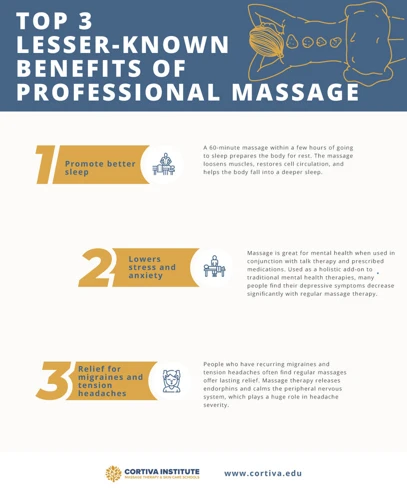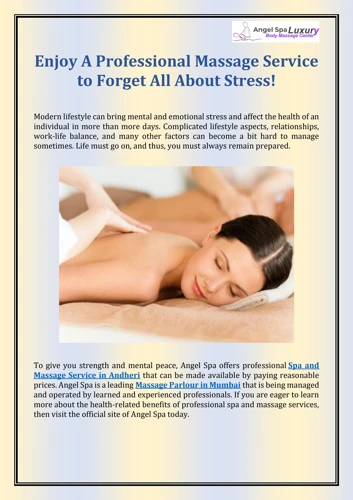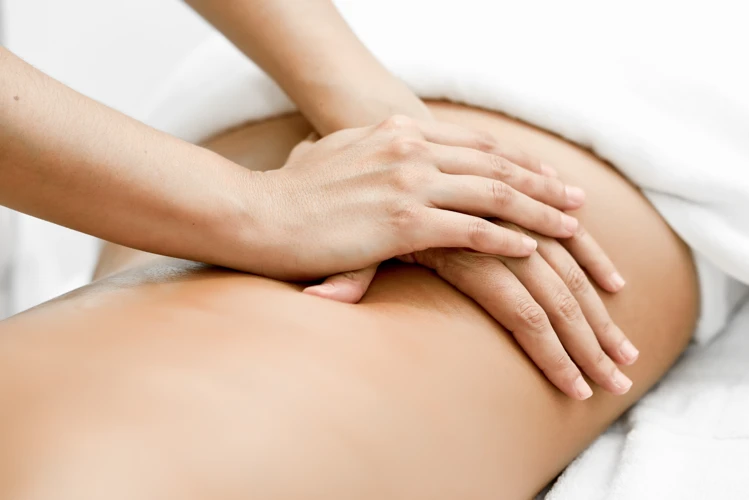Are you looking for tips on how to give a professional massage? Whether you are a massage therapist, a spa or salon owner, or a massage enthusiast, giving a professional massage can be a great way to relax and connect with someone. With the right knowledge and techniques, you can give a massage that is both enjoyable and therapeutic. In this article, we will provide expert tips on how to give a professional massage, so that you can bring out the best in your clients and get the most out of your massage.
Contents
Benefits of Professional Massage

Professional massages offer a wide range of benefits, from pain relief to improved mental wellness:
- Relieves muscle soreness and tension
- Improves circulation and reduces inflammation
- Reduces stress, anxiety, and depression
- Improves sleep quality and concentration
- Improves self-image and boosts confidence
A professional massage can also help with conditions such as chronic pain, headaches, migraines, and more. It can even help you recover more quickly from an injury or surgery.
When it comes to how do you massage, a professional massage therapist can tailor the massage to your needs, helping you get the most out of the experience.
Preparing to Give a Professional Massage

Gather Supplies
Before you can give a professional massage, it’s important to make sure you have the right supplies. This includes a massage table, massage oil, a variety of towels, music and pillows. Having the right supplies will ensure your client is comfortable throughout the massage.
Choose a Massage Technique
There are many different types of massage techniques to choose from. Before you begin, it is important to decide which technique you will use. Common massage techniques include Swedish, Thai, Shiatsu, deep tissue, and sports massage.
Create the Right Ambience
Creating the right ambience is key to giving a professional massage. You should make sure the room is comfortable and warm. Lighting should be dim, and you should play calming music to help your client relax. It is also important to ensure that the massage table is comfortable and the oil is warm.
By following these tips, you can give a professional massage that your clients will love. With the right supplies, technique, and ambience, you can give a massage that will help your clients relax and feel rejuvenated.
Steps to Give a Professional Massage

Warm Up the Muscles
Start your massage session by warming up the muscles of the person you are massaging. Use gentle strokes to stimulate the blood flow and prepare the body for the massage. If you are using oil, start with a light pressure and gradually increase it.
Applying Pressure and Massaging Muscles
Apply pressure to the muscles using your hands, fingers, and thumbs. Start by using light pressure and then gradually increase it. When massaging, use kneading, circular, and tapping motions. Focus on areas of tension and use slow, smooth strokes.
Applying Different Massage Strokes
When massaging, use different massage strokes and techniques to target different areas of the body. These techniques include effleurage, petrissage, friction, and trigger point therapy. Use these techniques to relieve tension and to provide a relaxing massage.
Adjusting the Pressure
Adjust the pressure of your massage according to the person’s needs. If the person is in pain, use light pressure and if the person is relaxed, use a firmer pressure. Be sure to listen to the person’s feedback and adjust the pressure accordingly.
Cool Down the Muscles
After massaging, cool down the muscles by using light strokes and gentle pressure. This will help to reduce any stiffness and soreness that the person may be feeling.
Finishing Up
To finish up your massage session, have the person lie down and relax. Offer some water or a hot towel, if desired. Allow the person to rest for a few minutes before ending the session. With these tips, you can give a professional massage and help the person relax and feel better.
Tips for Giving a Professional Massage

1. Prepare the Room: Make sure the massage room is clean and comfortable. Have a massage table, towels, and oil ready for the client. Set the mood with soft music and a warm atmosphere.
2. Choose the Right Massage Oil: Choose an oil that is suitable for the client’s skin type. A light oil such as almond or apricot kernel oil is best for sensitive skin.
3. Assess the Client’s Needs: Ask the client about any areas that need special attention. Is the client having trouble with back pain or headaches? Are there any other conditions that need to be addressed?
4. Use Proper Massage Techniques: Make sure to use the correct massage techniques. This includes using the right amount of pressure, using long, smooth strokes, and focusing on the client’s problem areas.
5. Communicate with Your Client: Ask your client for feedback throughout the massage. This will help you adjust the massage to their needs and ensure that they are comfortable.
6. Offer Aftercare Advice: After the massage, give your client advice on how to massage better, such as using ice or heat, stretching, or taking a hot bath. This will help them get the most out of the massage.
Common Massage Mistakes to Avoid
- Not asking about the client’s comfort level: Before you begin your massage, it’s important to ask the client about their comfort level. This helps you determine the pressure and techniques you should use during the massage.
- Not communicating during the massage: Make sure to communicate with the client throughout the massage. Ask them how they’re feeling, if they need more or less pressure, or if they would like you to focus on a particular area. This helps you ensure that the massage is comfortable and beneficial for the client.
- Using too much pressure: It’s important to use the right amount of pressure during the massage. Too much pressure can cause discomfort and pain for the client. Make sure to check in with them frequently to ensure the pressure you’re using is comfortable for them.
- Not washing your hands: Before and after each massage, it’s important to wash your hands. This helps prevent the spread of germs and bacteria and ensures that the client’s massage experience is sanitary and safe.
- Being too rough: Massage should never be painful or uncomfortable. If you’re using too much pressure or being too rough, you can cause damage to the client’s muscles. Make sure to talk to the client throughout the massage and ask them how they’re feeling to ensure you’re using the right amount of pressure.
- Being unprepared: Before you start your massage, make sure you have all the necessary supplies and equipment. Make sure you have enough massage oil, towels, and pillows for the client. Being prepared helps ensure that the massage will go smoothly and that the client is comfortable.
Frequently Asked Questions
What Equipment Will I Need to Give a Professional Massage?
Massage Table – This is the most important piece of equipment for giving a professional massage. It should be comfortable, adjustable, and sturdy.
Massage Oil – This is used to reduce friction and help the massage therapist to move the skin smoothly.
Massage Towels – These are used to cover the body during the massage, as well as to clean up any oil or sweat.
Massage Pillow – This is used to provide support for the head and neck so the client can relax and enjoy the massage.
Massage Chair – This is used for chair massages and can provide a comfortable and relaxing experience for the client.
Handheld Massager – This is used to provide more intense pressure during the massage.
Massage Lotion – This is used to provide a smoother massage and can be used in combination with massage oil.
How Can I Ensure I Give the Perfect Massage?
- Pay attention to details: Take your time during a massage, paying attention to the client’s body language and any changes in their breathing. Use a variety of massage techniques and adjust the pressure accordingly.
- Choose the right oil: A good massage oil will provide the right amount of lubrication. Choose a natural oil that is hypoallergenic and non-staining.
- Create a relaxing atmosphere: Create a calming atmosphere with dim lighting, relaxing music, and a comfortable temperature.
- Communicate with your client: Communicate with your client throughout the massage to ensure the pressure and technique are comfortable.
- Be confident: Your confidence will show in your massage technique and will help your client relax.
What should I do if the person receiving the massage is uncomfortable?
If the person receiving the massage is uncomfortable, pause the massage and ask them if they are okay. If they indicate they are still uncomfortable, offer them a break or the opportunity to stop the massage altogether. Maintain a professional and understanding demeanor to ensure your client feels safe. Be sure to explain any sensations that may arise during the massage, such as a deeper pressure or an extension of a stretch, so the person receiving the massage is aware of what is happening. Offer them a blanket or other comfort item if needed.
How Often Should I Give a Massage to the Same Person?
It is best to give a massage to the same person no more than once a week. Give your clients time to heal and rest between massages. Depending on the person’s needs, you may want to space out their appointments further. Listen to their feedback and tailor your massage sessions accordingly.
What Should I Do if I Experience Pain in My Hands During the Massage?
If you experience any pain in your hands during the massage, stop immediately and take a break. It is important to rest your hands and wrists to prevent any further injuries. If the pain persists, consult a doctor to rule out any underlying medical conditions. Make sure to use proper form, take regular breaks, and keep your hands warm while massaging to help prevent any discomfort or pain.
Conclusion
Giving a professional massage requires practice and dedication. With the right techniques and tips, anyone can give a professional massage. Make sure to pay attention to the client’s needs and preferences, warm up the area, use proper pressure and movements, and keep the client comfortable. With these steps and tips, you can give a professional massage that your clients will enjoy.

